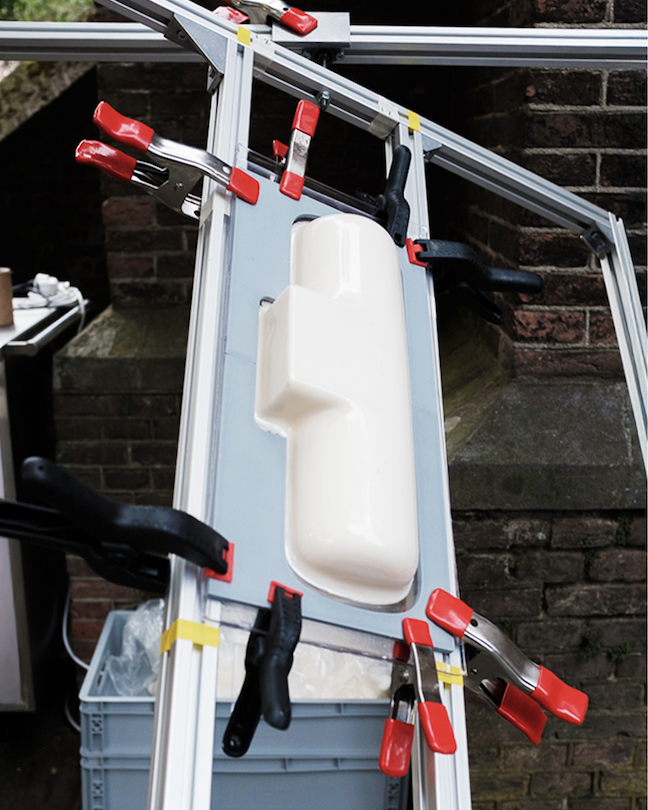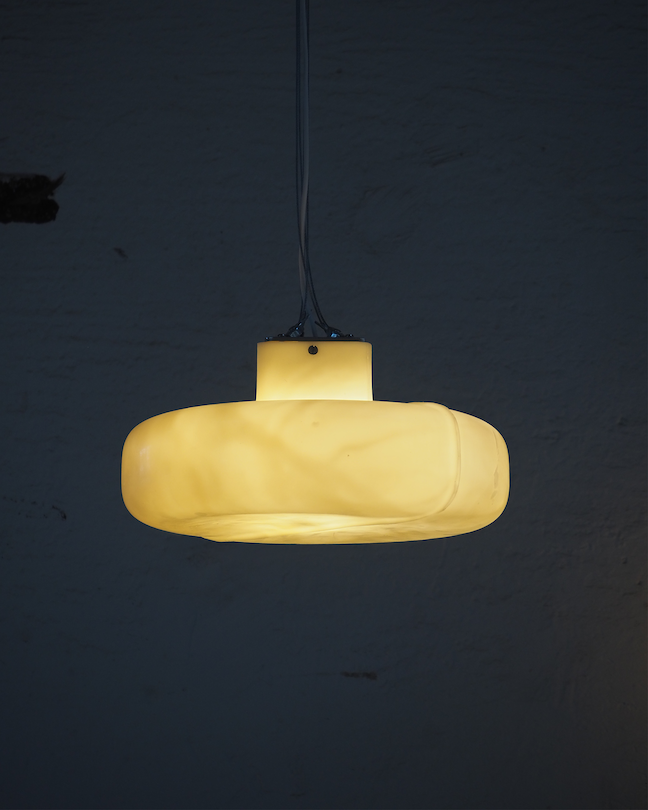Butter Wouldn’t Melt
Baguette Studio’s wax lamps are made using rotational moulding, a process typically employed in plastics production (image: Baguette Studio).
Baguette Studio’s wax lamps resemble wheels of cheese or bricks of butter. When lit, they glow like marbled honey, revealing the patterns the wax formed while hardening. Despite their natural appearance, however, their texture is more akin to an industrial material. “When you touch the lamp, it’s really a completely different material than what you expect from wax,” says designer Philippe Gaud, who cofounded the Paris-based studio with Emma Lohner. “It feels like plastic – the surface isn’t greasy at all.”
It is perhaps unsurprising that the wax lamps were able to take on some of the features of plastic, given that the project began when Gaud and Lohner decided to investigate rotational moulding, a process typically employed in plastic production. “We wanted to use an alternative to plastic, and the idea was to find a material that would withstand heat and be easily mouldable,” Gaud says, explaining how they created a rotational moulding machine using YouTube tutorials, and began experimenting with different wax recipes. The studio aimed to find a recipe that would withstand up to 80° of heat without melting, and after creating around 50 different material tests, ranging in colour from burnt biscuit to golden egg yolk and creamy white, the team landed on their buttery mixture of beeswax and plant-based wax. “There aren’t any other long-lasting objects made out of wax; it’s only used for temporary objects,” Gaud says. “So troubleshooting production problems was tough, because there was no history to learn from. You kind of just have to improvise.”
Material tests using different recipes of wax (image: Baguette Studio).
Unlike in traditional rotational moulding, where a heated mould is used to melt plastic pellets, the studio’s process involves heating wax into a liquid before pouring it into the mould. The rotational moulding machine then spins the mould in order to coat it evenly with the wax and cool the material down until the shape has set. “Then, we can easily cut out the base and assemble the electronics,” Gaud says. “We do that while it’s still warm, so there’s no chance of cracking.” The material is able to transform from raw material to finished object in only 45 minutes, allowing the studio to produce products directly in front of their customers. “We hope that it demystifies industrial processes, and gives people a better understanding of how things are assembled and how they could be disassembled,” Gaud says. “And we hope that it could build a better connection with the object, if you've really witnessed it being made.” The pair also enjoy forming closer relationships with their customers and sharing the excitement of watching the material transform. “It’s nice as a maker to not be confined to the shadows,” he says.
The rotational moulding machine can create objects in just 45 minutes, allowing the studio to make their pieces in front of customers (image: Baguette Studio).
Each of the studio’s three lamp designs – a mushroom-shaped table lamp, a rectangular wall lamp and a circular hanging lamp – all use the same weight of wax. “We wanted to illustrate the concept of owning material rather than owning an object,” Gaud says, explaining that each lamp can be returned to the studio and melted down into a different shape. “Maybe you move from one place to another and you don’t have a spot for a wall light anymore, so you reshape it into a table lamp,” he continues. “Having something that follows you around for years is what interests us.” All of the lamps use the same base and electronics, which were created by OpenStructures, a design studio based in Brussels who have developed a grid of standardised components. “The electronics can go back into the open structure system and become new objects,” Gaud says, explaining that the studio wanted to make every part of the lamp recyclable so that customers have the option of transforming it into different products as the studio expands their catalogue. “A lot of people think wax is fragile, but actually, if you design the right shape and proportions, it can be really strong,” Gaud says. “I think designing a stool would be a great way to show that.”
All three of the studio’s lamp designs use the same amount of wax, so that they can be melted down and turned into a different model if a customer’s desires change (image: Baguette Studio).
By tinkering with the production process and creating products that continuously evolve, Gaud and Lohner are also able to give the studio the freedom to grow and change. Currently, the pair only sell limited edition batches of products that are available to collect from their studio in Paris or to purchase during in-person events, a move which gives them the time to develop new designs. Despite their emphasis on creating new work, customers will always be able to access the studio’s full range of product typologies if they decide to remelt their objects - the wax from two lamps could be melted down to become a stool, for example - enabling customer choice while giving the designers the space to work towards their ultimate aim of trying the experiment all over again. “I think next we would like to go for extrusion or injection, a big industrial method that’s usually very hidden, and really bring it to the people,” Gaud says.




